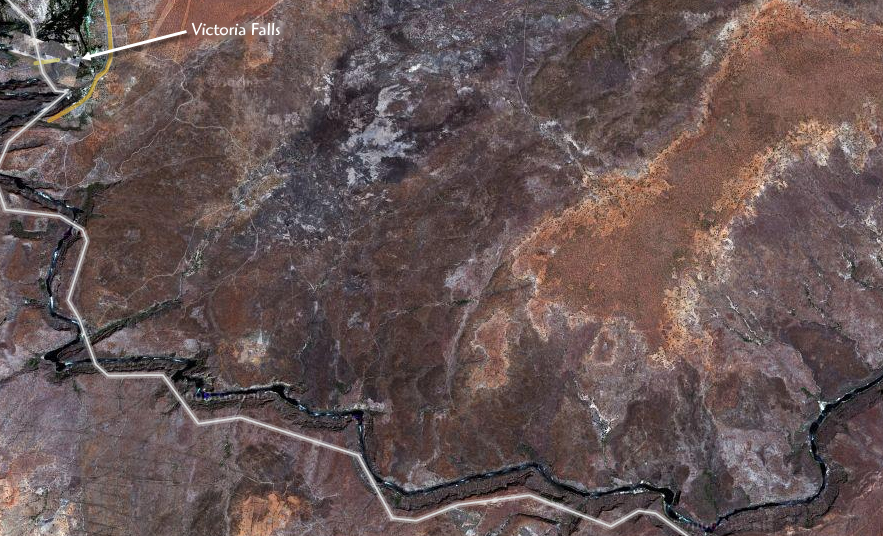
Southern Africa, on the border of Zambia and Zimbabwe
August 10th - 21st, 2008 High water
By Jon Fowlkes
The Zambezi is known for many things, but two aspects of this river really stand out in my mind.
First: The Hugeness. I don't even know if Hugeness is a word, but if it isn't, the Zambezi necessitates its creation. This river runs on a scale few ever get a chance to - or perhaps want to - experience. Flows range from 20,000 cfs, which is considered low ( Yes, low. 20,000 cfs is considered low, that is not a typo ) to high flows of 300,000 cfs ( Yes, that is three hundred thousand cfs. Again, not a typo ).
A village we passed on the way to the river.
After years of kayaking around the world from my home base in Portland, Oregon I had decided to become a doctor. Nothing puts a crimp in your paddling like medical school, so I hadn't been getting out much. Summer rolled around and I was ready for some play time. An opportunity arose to do some volunteer work in Tanzania, and the beginnings of a cunning plan began to germinate..
After a month and a half of volunteer work in Tanzania, I was ready to go paddling. I had heard stories of deep gorges, big holes, and complex big water rapids from fellow Oregonian and Zam veteran Mike Long, so I decided to head south to the Zambezi. The river is located on the border of Zambia and Zimbabwe, so getting there took a little bit of traveling.
Several busses and a plane ride later I found myself checking into Faulty Towers hostel in Livingstone, Zambia. I contacted Hamish, who Mike had assured me would set me up with a boat and gear. Hamish was very helpful and set me up with a boat and I was able to join a 3-day raft supported trip with his company Water By Nature.
In the morning I caught a ride to Victoria falls to look around and get a feel for the river.
With the help of a local 'guide' I walked out on the lip of the falls to a natural pool called the Devil's Armchair where I swam just feet away from the 300' drop. A small trickle of water left the pool and plunged off the edge as I carefully pulled myself out to the brink to stare into the abyss and gawk at the massive massive minus rapids. Even from 300' above, they looked terrifying ( what little I could actually see through the heavy mist ).
Looking downstream I could see Rapids Number One, Two, and Three on the regular run, all of which which looked pretty reasonable. Satisfied, I returned to town, outfitted my boat and packed up my gear for the trip. In the process I met Matt from England and Rachel from New Zealand, who were also in town to paddle. Matt had already been on the river many times and was a fantastic resource for logistical information as well as very helpful once we were on the river.
Looking down into Victoria Falls and the rarely-run 'Minus Rapids' in the Batoka Gorge.
Our Burly Zambezi shuttle rig.. We could use one of these in Oregon!
In the morning we drove to the put-in at Victoria falls and had a leisurely hike down while porters carried the rafts and kayaks into the gorge. We put in at rapid Number One in the eddy. From the Zambian ( river-left ) side, Number One is simply a ferry across a large fast wave train that you had to make before the entire flow piles into a rock wall. The rafters were a bit nervous as the level had just come down enough to raft the section the day before so we were only the second trip of the year.
I ferried out and after a couple bounces was across and fighting my way over the far eddyline. Our first raft made it out fine but the second raft got flushed into the wall and everyone went in the drink. As the rafters swam by me, I peeled out and found myself chasing the empty raft downstream, running Number Two and Number Three blind ( which was fine ). I later found out most commercial trips put in below Number One to avoid the possibility of a flip there.
Matt running the rapid known as Number One. Most commercial trips put in below this rapid to avoid the wall downstream.
Downstream of Number One the river forms a small wave train with some good surfing at the right flow. It was borderline too high when I was there but occasionally we could get some fun fast surfs in. This rapid is known as 'Number Two', or 'The Bridge'.
Matt surfs at Rapid number two, also known as 'The Bridge'. This spot has good surfing at lower water.
Downstream of Number Two is Number Three, a big green tongue leading into a massive pile on the left or a crashing lateral on the right. Good playboaters can tear it up in the pile but most mortals opt for a straight run down the middle, as shown below.
Matt running Rapid number three.
Just below Number Three is Three and a Half, with more good surfing.
The first 'big' rapid is Number Four, also known as 'Morning Glory'. At Morning Glory there are big holes on the left and right and a crashing wave in the middle. This is where the Zam starts to flex its muscles a little..
Matt drops in to Number Four, also known as 'Morning Glory'. This hole is huge!
Number Four eats a raft for lunch.. Yes, that's a fully loaded commercial boat with six passengers.. Gone!
Below Number Four the run mellows briefly with some flat water and then the level rises due to a power station dumping water back into the river.
Just downstream is Number Five, also known as 'Stairway to Heaven'. This is the first rapid that has the massive, intimidating features that the Zambezi is known for. At Number Five a big pourover on both the right and left lead most to the middle green tongue and through a series of massive, crashing waves. Hero lines exist on the left or right, especially if you go for the boof on the river right pourover, where you can expect some serious downtime.
Matt gets tossed around in Number Five, also known as 'Stairway to Heaven'.
A raft finishes up big on Number Five..
Just below Number Five is Five and a half, which has some little waves leading up to Number Six, also known as 'Devils Toilet Bowl'. This rapid was nothing much compared to the other rapids, more or less read and run..
The next big drop is Number Seven, also known as 'Gullivers Travels'. Here the river divides around several midstream rocks before tearing through a channel with several obstacles.
On river left there is a large hole known as 'The Crease', and on river right is 'The Gap', a narrow slot between two boulders which has caused serious carnage in the past. A clean run through Number Seven requires you to eddy out behind a boulder, then charge right through some laterals to just catch the right corner of The Crease while driving back left to avoid The Gap.
If done successfully, these opening moves deposit you straight into 'The Land of Giants' where big haystack waves appear and disappear while you try and navigate them. At this level, Number Seven was by far the most difficult and consequential rapid on the river ( excluding Number Nine of course ).
Looking upstream at Number Seven, also known as 'Gullivers Travels'.
Just below Number Seven is Seven B, a smaller drop which features more fun waves with some good surfing at the levels we had.
Next is Number Eight, also known as 'Midnight Diner'. This rapid is wide open, with lots of line ranging from easy to hard depending on what you want.
Just downstream is Number Nine, also known as 'Commercial Suicide'. Number Nine is one of the most fearsome and infamous rapids on the Zambezi. At the healthy flows we had, the majority of the river pours over a ledge into a massive hole in the middle and right at the top. Beginning on the left bank a huge lateral crashing diagonal provides a potential line through an eight-foot wide slot.
Just behind the lateral is a large hole on river left. Downstream most of the flow dropped into the largest wave-hole I've ever seen. The line is to partially punch the curler then let it take you towards the middle and through the slot between the two massive holes then sort yourself out and hang on for a ride ( or try and dodge right ) of the massive wave-hole waiting at the bottom. I never worked up the gumption to run this one, it was just too big to wrap my head around.
No commercial rafting companies run Number Nine, everyone walks. I only heard of one kayaker running Number Nine the two weeks I was there.
The top hole in Number Nine. At the high flows we had this drop was the most consequential on the upper section.
The bottom hole in Number Nine. This is the biggest wave-hole I have ever seen. A raft runs through Number Nine.
Just downstream of Number Nine is Number Ten, also know as 'Gnashing Jaws of Death'. This drop is another big wave-train that can be run right down the middle, no problem.
Looking back upstream at Number Ten, taken from our lunch spot.
We usually stopped below Number Ten for lunch ( hauled in by porters down a trail to the canyon rim ).
After lunch there isn't much warm up before Number Eleven, also known as 'Overland Truck Eater'. Eleven is yet another fun wave train we ran down the left, avoiding the big hole on the right.
Rachel runs Number Eleven, aka 'Overland Truck Eater'.
Just downstream is Number Twelve, which is broken into 12A, 12B, and 12C, also known as 'The Three Sisters'. At certain flows the play wave in 12B is one of the finest in the world, with spinning sections, a large pile, and front-surfing sections. Unfortunately on this trip the flows were much too high for the play wave, but maybe next time.
The Twelves are are all in a short canyon section and blended together at the high flow we had. We entered this series of rapids in a river left channel, crashed through some curlers and waves, then tried to stay upright while navigating big boils and eddylines down through 12B and C.
The Three Sisters flush straight into Number Thirteen, also known as 'The Mother'. Mother is another massive massive wave train.. I remember coming through the first wave, it was so big that my stomach would drop as I slid off the backside of the wave! What fun! The river was moving fast and the eddies were too boily to get out for photos.
Downstream is Number Fourteen, which featured more small waves at this flow.
Number Fifteen ( also known as 'Washing Machine' ) is up next. Here a green tongue leads into some crashing waves then into a boat-eating hole which can be dodged either on the left or right ( or not dodged.. ) Some boily eddylines on both sides made this a bit tricky.
Rachel enters Number Fifteen, also known as 'Washing Machine'.
Will chooses not to dodge the hole at Number fifteen, also known as 'Washing Machine'.
Just below Number Fifteen is Rapid Number 16 A, B, and C, also known as 'The Terminators'. The Terminators feature more clean read and run fun with big waves.
Below The Terminators are rapids Seventeen through Twenty-Five, where the river calms down somewhat. Mostly these rapids are smaller with the occasional bigger wave but nothing compared to the upper section. There are still plenty of big boils and tortuous eddylines to manage though. Number Seventeen is also known as 'Double Trouble', and Number eighteen is known as 'Oblivion'. At low flows in September-October, Oblivion forms the huge wave-hole featured in all of the paddling carnage videos.
Most commercial raft trips take out either at Number Ten ( a half day trip ), or at either Number Twenty-Three or Twenty-Five ( a full day trip). We did one multi-day trip, which continued downstream another day from Number Twenty-Five through more mellow whitewater punctuated with a few massive rapids.
On this lower section there are three really big ones: First is The Narrows, a long, deceptive rapid which consists of battling lots of boils and eddy-lines. Next up many smaller rapids lead to Chumumba, another large complex rapid. Here much of the flow crashes into the right wall forming some powerful seams. Portaging is easy on the left.
Just downstream of Chumumba is upper and lower Moemba falls. The upper 'falls' is similar to the larger rapids upstream. Lower Moemba is a river wide ten-foot ledge with massive boils to negotiate and looked extremely difficult to me at the flows we had. Purportedly, kayakers run this drop but it carries a fair amount or risk. At least one person has died here.
Lower Moemba Falls
Downstream the river flattens for a ways before crashing through Ghost Rider and son of Ghost Rider, another large, complex wave train. After our multi-day trip they helicoptered the equipment and clients out of the gorge while I hiked out at lower Moemba with much of my gear.
An African-sized campfire!
Logistics and Accommodations: You can access the Zambezi from either the Zimbabwean or Zambian side of the river. Be sure to check before you fly, because right now Zimbabwean side of the river is in political turmoil and relatively unsafe for traveling. When it is stable, you can fly into Harare and bus to Victoria falls or fly into Victoria Falls, but that is not done very often these days.
I accessed the river from the Zambian side, which is much safer for foreign nationals. From the Zambian side you can fly to Lusaka and bus to the city of Livingstone ( eight hours, $23 ) or fly to Livingstone. Zambia also shares a border with Botswana and Namibia near Livingstone.
In Livingstone there are two popular guest housess - Faulty Towers and Jollyboys. Jollyboys is a little nicer and had a better social scene. Both have individual rooms, dorm rooms, and camping on the lawn ( $5-30 / night ).
Livingstone is about five miles from Victoria Falls, which is also the put in. Most of the times I ran the river, I caught a ride with Bundu Rafting, a local company run by french kayaker Nico Chassing. Nico was very helpful and accommodating and runs a good business.
Alternatively, some taxis have roof racks and for $7-$10 offer a ride to the put-in. However, be forewarned, finding a taxi driver who knows the location of the take-outs can be more challenging..
Gear is available from several sources. Nico has a few sets of gear he rents out ( bunduadventures.com ) . Grubby from Raft Extreme has some boats and paddles and Hamish from thezambezi.com also had gear for rent. I paid about $120 a week for a full setup.
The Zambezi is located on the border of Zambia and Zimbabwe, as shown by the pointer on the map below, courtesy of Google Maps.
A slightly zoomed-in view of the Zambezi, courtesy of Google Maps.
A zoomed-in view of the Zambezi, courtesy of Google Maps.

Second: The Scenery. The Zambezi has possibly the single most spectacular put-in of any run I have ever seen. Just upstream of the regular run Victoria Falls thunders down into the Batoka Gorge. These massive towers of water plunge into the river year-round in a spectacular display of power. The river is over a mile wide at the falls, and the steam rising from the falls can be seen over ten miles away. In 1989 Victoria Falls was declared a UNESCO World Heritage site, so the falls draw a lot of tourists.



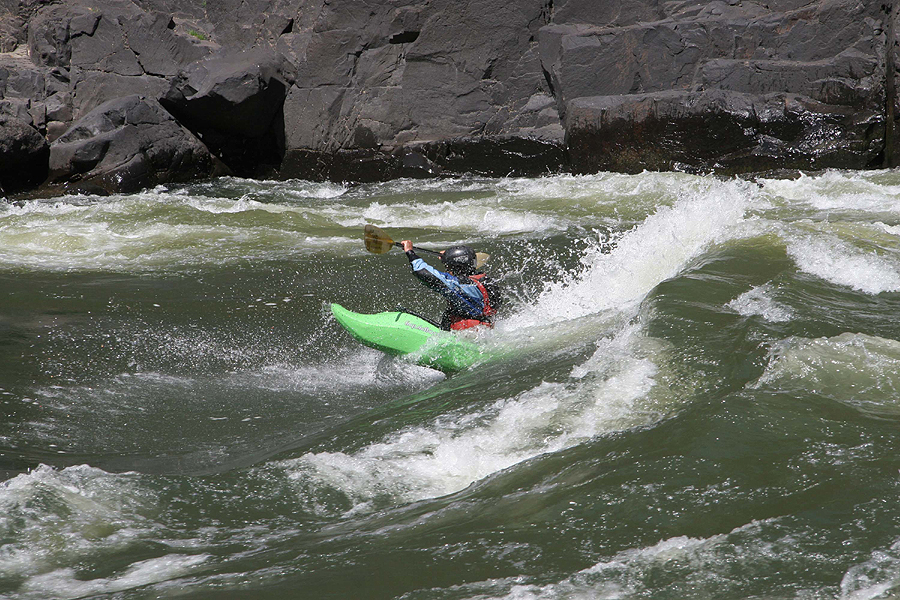
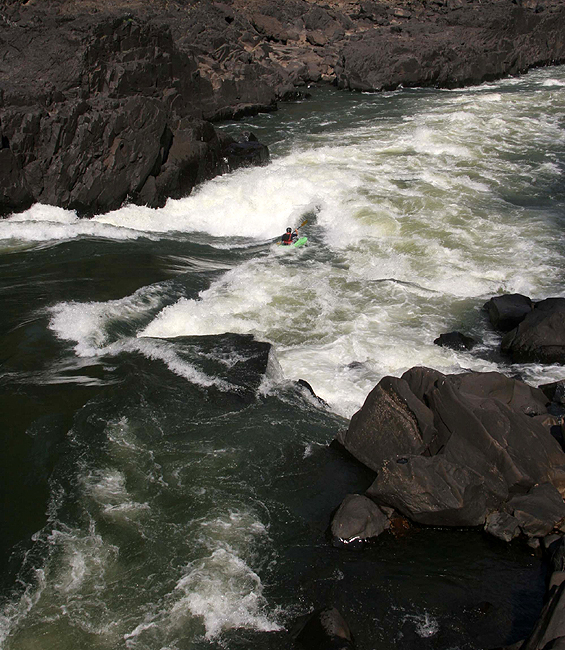
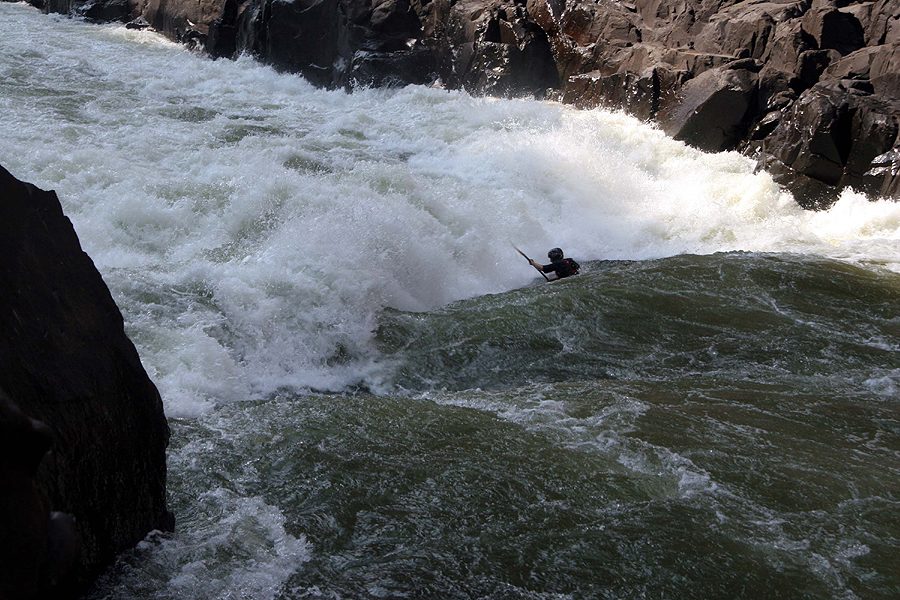
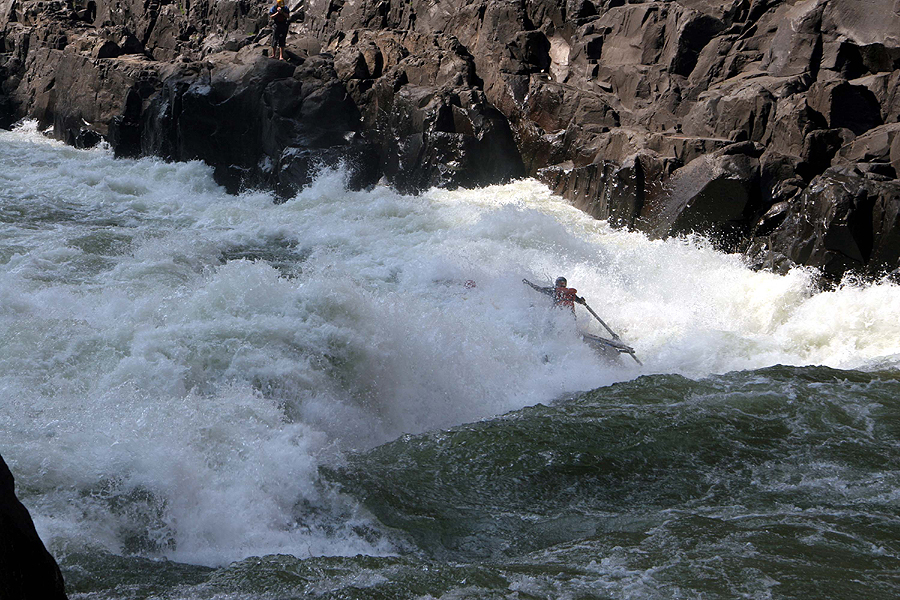
This rapid is massive, photos don't even come close to doing it justice.
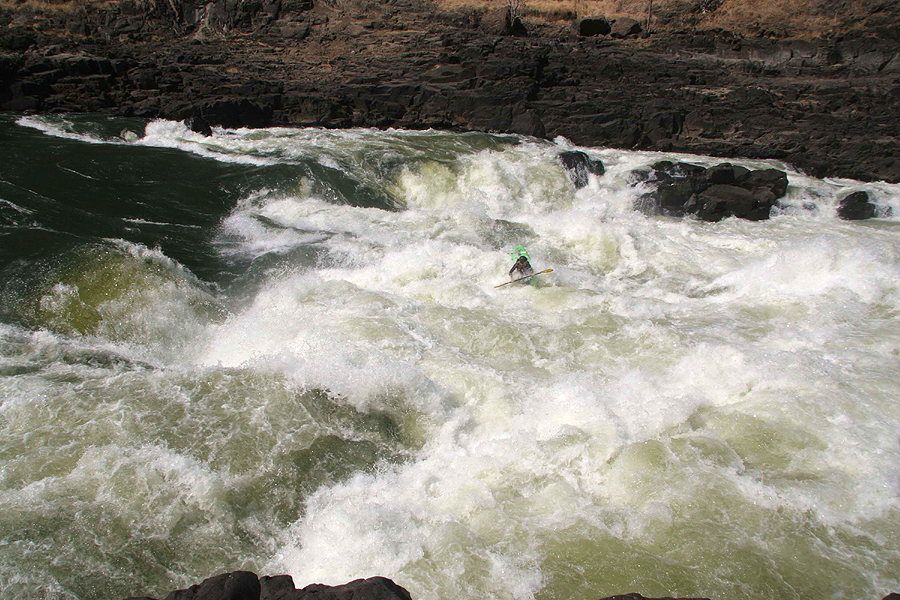
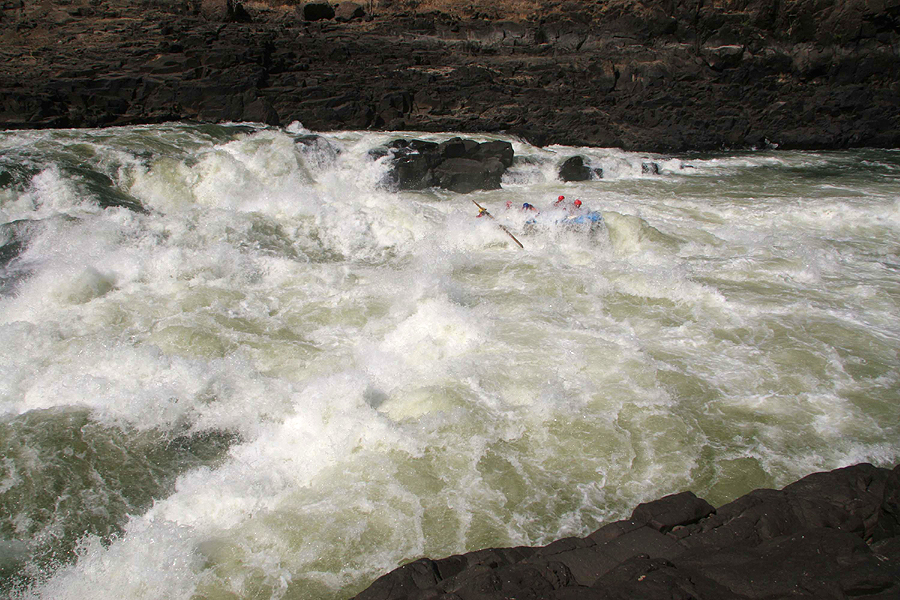

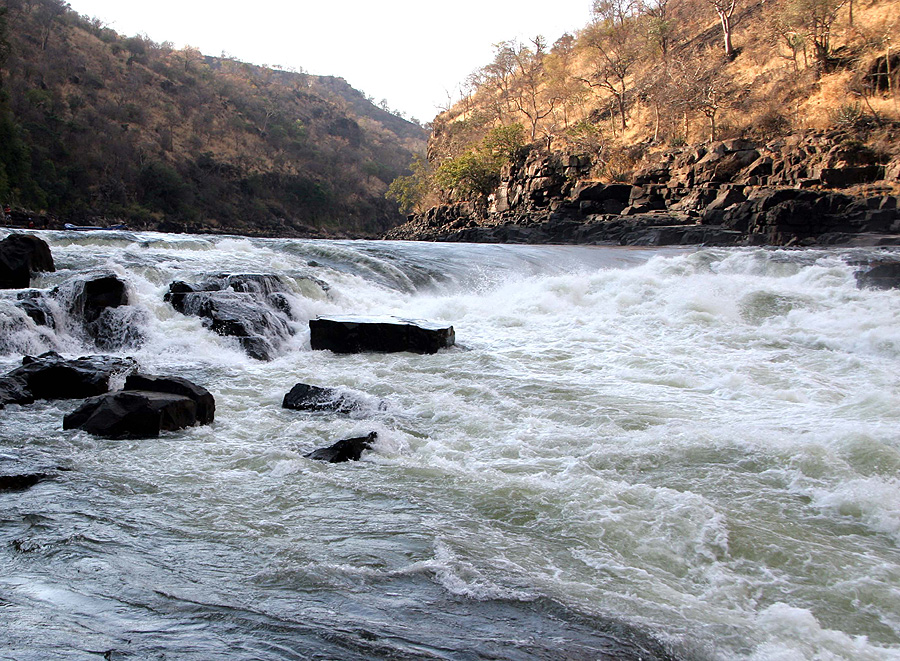
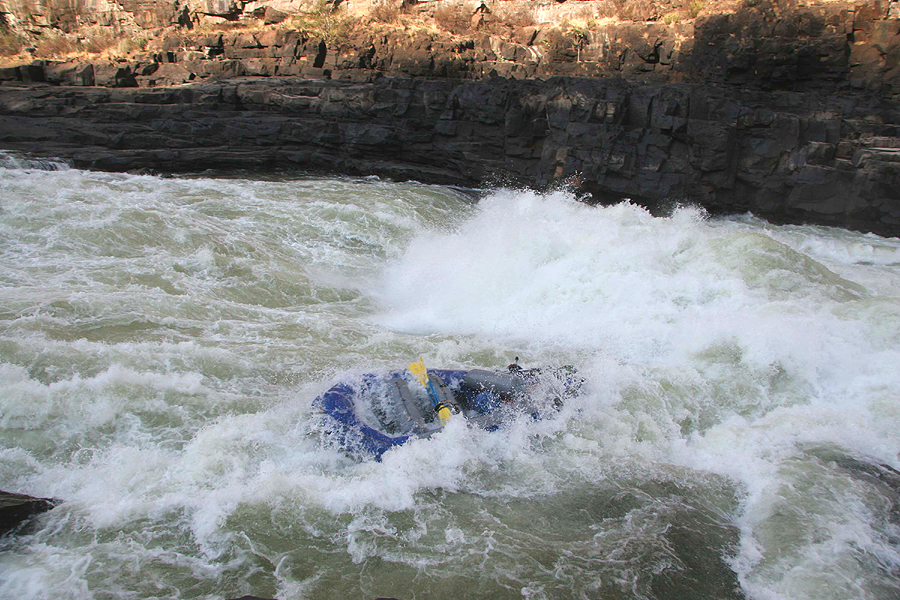


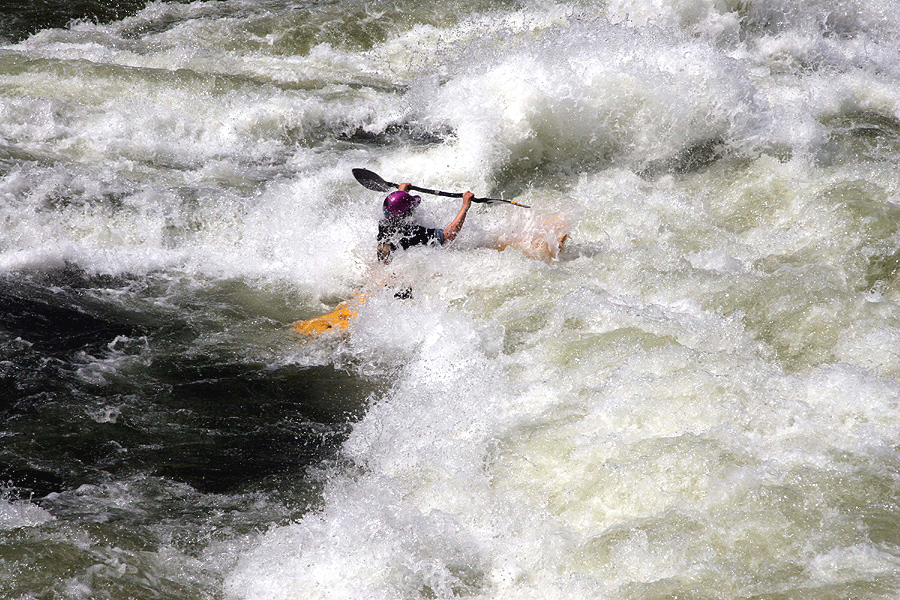
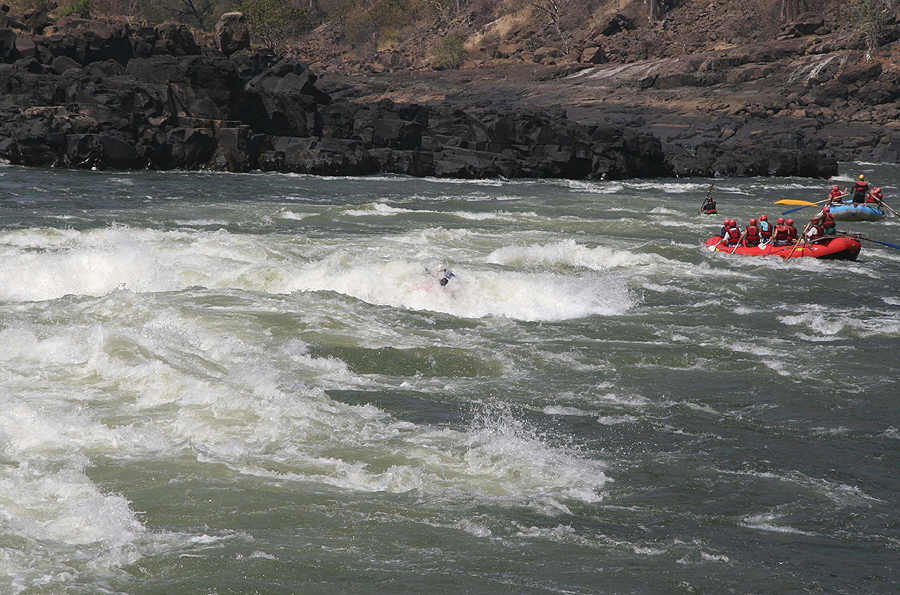
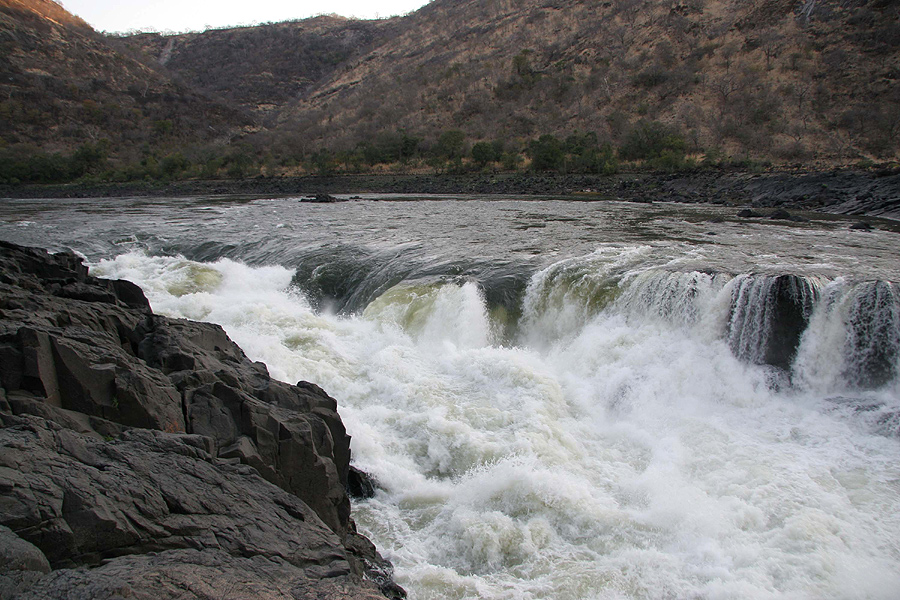


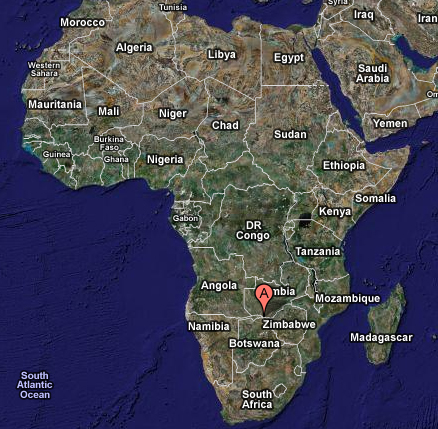

The scale of the rapids are clearly visible from even this high up..
